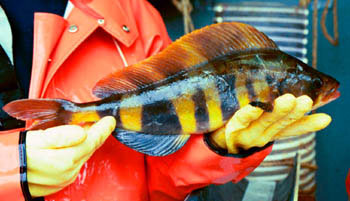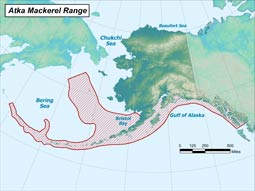Atka Mackerel
(Pleurogrammus monopterygius)
Species Profile
Did You Know?
Male Atka mackerel guard nests until eggs hatch.
General Description
Atka mackerel Pleurogrammus monopterygius is a gregarious, semi-pelagic and semi-demersal hexagrammid that is distributed in the continental shelf regions across the North Pacific Ocean and Bering Sea from Asia to North America. On the Asian side their distribution extends from the Kurile Islands to the Gulf of Anadyrskiy. From Kamchatka, they extend eastward through the Komandorskiye and Aleutian Islands, north to the Pribilof Islands in the eastern Bering Sea, and eastward through the Gulf of Alaska to southeast Alaska. Their center of abundance is in the central and western Aleutian archipelago where a directed commercial trawl fishery operates. Atka mackerel is a key prey item for marine fishes, birds, and mammals, including the endangered Steller sea lion.
Life History
Growth and Reproduction
Atka Mackerel first appear in trawl surveys and the fishery at ages 2–3 and many survive to 14 years. Fifty percent of the female population is estimated to have reached maturity at 31 cm (about 3.6 years old). Atka mackerel migrate from the shelf edge to shallow coastal waters (5-30 m) to spawn. Spawning occurs in July -October along the Aleutian Islands. Eggs are adhesive and deposited in rock crevices. These nests are guarded by the males until hatching, which occurs about 40-45 days later. Atka mackerel are obligate demersal spawners. Females lay adhesive eggs on rocky substrate and males guard the nests to protect eggs against predation and cannibalism. Locations of spawning and nesting grounds within Alaska are unknown. The only published account of an Atka mackerel spawning site in Alaska is by Turner (1886). Turner (1886) noted that spawning Atka mackerel, when observed from the water’s surface, appeared to form several strata with the least mature fish in the top layer and spawning “vigorous males and females” in the bottom stratum. He reported that females deposited eggs on kelp and that both sexes remained for one month, from June to July, and then departed. Turner’s (1886) observations contradict the more recent accounts by Gorbunova (1962) and Zolotov (1993), who used scuba for direct observation of nesting grounds in Kamchatkan waters. Their observations of spawning and nesting sites were confined to coastal areas, and the minimum and maximum depths for spawning and nesting ranged from 10 m to 32 m. Both authors report that Atka mackerel were segregated by sex and size, that eggs were laid only on rocky substrates, and that males guarded nests for protracted periods lasting months. Bottom type, depth, and temperature along with moderate tidal current were reported as being important factors for a nesting site. The temperature range for nesting sites was between 5°C and 8°C. The Russian studies, however, were limited in scope both in terms of methodology and spatial coverage. Characteristics of nesting sites off the Kamchatka Peninsula may not be representative of nesting sites over the entire geographic range of Atka mackerel, and scuba has depth limitations that could have prohibited direct observations of nesting sites in deeper water.
Related Report: Geographic Distribution, Depth Range, and Description of Atka Mackerel Pleurogrammus monopterygius Nesting Habitat in Alaska (PDF 4,330 kB)
Feeding Ecology
The diet of Atka mackerel varies but is dominated by copepods and euphausiids.
Migration
The predominately pelagic behavior of Atka mackerel changes during spawning when they become demersal. During spawning they move from the edge of the continental shelf to shallow, nearshore waters, where they form dense spawning aggregations.
Range and Habitat
Atka mackerel range from the Kamchatka Peninsula in the west, through the eastern Bering Sea, and eastward through the Gulf of Alaska to Southeast Alaska. The center of abundance is in the Aleutian Islands. The predominately pelagic behavior of Atka mackerel changes during spawning when they become demersal.
Status, Trends, and Threats
Status
The estimated biomass of Atka mackerel in the Aleutian Islands is at or near historic, post-1977 highs. Atka mackerel are not overfished nor nearing an overfished condition. In the 5-year period ending 2004 Atka mackerel harvest in federal fisheries has averaged almost 119 million pounds (54,000 mt) worth an average of almost $12 million (5-yr avg harvests, 2000-2004, historical harvests, 1977-2004). State-waters catches average less than one tenth of a percent of the federal catches. There was an average of 14 vessels in this fishery (5-yr avg harvests, 2000-2004).
Trends
An Atka mackerel population in the Gulf of Alaska, in the Kodiak, Chirikof and Shumagin areas supported a large foreign fishery through the early 1980s. This population had apparently disappeared by the mid-1980s. Recent reappearance of Atka mackerel in surveys has led to the suggestion that the Gulf of Alaska Gulf of Alaska may be at the edge of the range for the species. Because of generally low and fluctuating populations, the fishery for Atka mackerel in the Gulf of Alaska is a bycatch-only fishery.
Threats
Other fish, marine mammals and sea birds prey upon Atka mackerel. Like pollock and Pacific cod, Atka mackerel is an essential prey item for Steller sea lions. As a result, measures were implemented for the Atka mackerel fisheries in the BSAI that included prohibitions on trawling within specified distances from rookeries and temporal and spatial dispersion and reduction of fishing within sea lion critical habitat. Fishing effort has also been dispersed through management action to reduce the chance of localized depletions of Atka mackerel.
Fast Facts
-
Range/Distribution
The center of abundance for Atka mackerel is in the Aleutian Islands. -
Diet
The diet of Atka mackerel varies but is dominated by copepods and euphausiids. -
Predators
Other fish, marine mammals, and sea birds prey upon Atka mackerel. -
Reproduction
During spawning Atka mackerel move from the edge of the continental shelf to shallow, nearshore waters, where they form dense spawning aggregations. -
Remarks
Atka mackerel are managed by Federal and State agencies.


